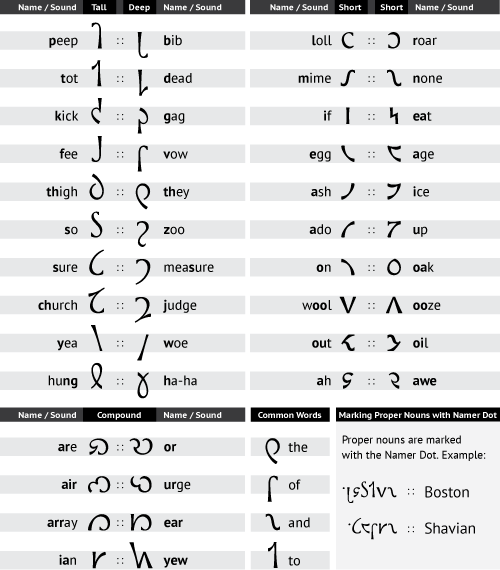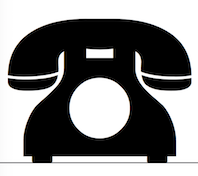TYPE DESIGN INFORMATION PAGE last updated on Mon May 6 08:57:35 EDT 2024
FONT RECOGNITION VIA FONT MOOSE
|
|
|
|
|
Shavian | ||
|
|
|
|
SWITCH TO INDEX FILE
Alan M. Stanier from Essex University (UK) has created the following metafonts: ams1, cherokee, cypriote, dancers (the "Dancing Men" code of Conan Doyle), estrangelo (ancient Syriac language), georgian, goblin, iching, itgeorgian, ogham (found on ancient Irish and pictish carvings), osmanian (twentieth-century font used in Somalia), roughogham, shavian, southarabian (for various languages circa 1500BC), ugaritic (ancient cuneiform alphabet). More direct access. [Google] [More] ⦿ | |
Great Unicode jump page. Has a page showing all fonts that support the various Unicode ranges. Check, for example, his Shavian Unicode sub-page. Unicode font utilities. Some font downloads, including the Unicode font MPH Damase (2005, Mark Williamson). [Google] [More] ⦿ | |
Aussie designer in 2001 of fonts for the Shavian alphabet: Europa and ShawScript. Downloads do not work. [Google] [More] ⦿ | |
DeMeyere Design Incorporated
| Ross DeMeyere's handwriting font. There are free fonts for Shavian called Androcles and Ghoti. [Google] [More] ⦿ |
Ethan Lamoreaux's page on the Shavian alphabet contains two Shavian fonts he made in 2003: esl_gothic_shavian (the Shavian characters are encoded where the Latin characters would normally go) and esl_gothic_unicode (the Shavian characters are located at both the Private Use area, starting at U+E700, and also in the Shavian area in plane 1 (surrogates) starting at U+10450). Fontspace link. [Google] [More] ⦿ | |
Owensville and/or Vincennes, IN-based art student (b. 1985) and designer of the Courier-like Shavian font Shaw Mono (2004), ChordBoxes (2010, to create chord diagrams), Bee Skep (2004, for Deseret), Box Puzzle Font (2010), Litterae Ignotae (2010: A Lingua Ignota (Latin for unknown language) was described by the 12th century abbess of Rupertsberg, Hildegard of Bingen, who apparently used it for mystical purposes. To write it, she used an alphabet of 23 letters, the litterae ignotae), Seftos Nandor (2004, for an artificial language called Lower Geldorian), Sëftos Parathenia (2005, also in the Seftos script), this decorative serif (2006, experimental), Alberne Handlung (2007, a narrow all-caps Latin and Cyrillic face), Swartsbok (2007, a nice gothic font), Lumaro (2007, in the style of Times-Roman), Duck Hunt (2004, fat display face, based on the lettering of the title of the game), Anquietas (2004, "the Ancient alphabet from Stargate"), Gothic Book (2005), and Dadh Ath (2004, containing the Ath characters used to write Baronh created by Morioka Hiroyuki and used in Sekai no Monshou). Spicer now lives in Terre Haute, IN. Another web page. [Google] [More] ⦿ | |
Designer of the Shavian font Lionspaw (1999). [Google] [More] ⦿ | |
Designer of a public domain Unicode font in 2005 called MPH 2B Damase. It can be found here. Created by Mark Williamson, it covers Armenian, Cherokee, Coptic (Bohairic subset), Cypriot Syllabary, Cyrillic (Russian and other Slavic languages), Deseret, Georgian (Asomtavruli and Nuskhuri but no Mkhedruli), Glagolitic, Gothic, Greek (including Coptic characters), Hebrew, Latin, Limbu, Linear B (partial coverage of ideograms and syllabary), Old Italic, Old Persian cuneiform, Osmanya, Phoenician, Shavian, Syloti Nagri (no conjuncts), Tai Le (no combining tone marks), Thaana, Tifinagh, Ugaritic, Vietnamese. See also here. The font is used by the popular Debian Linux software. Mark Williamson also designed a free fonts for Osmanya, Ugaritic and Shavian called Andagii (2003). His Penuturesu covers Linear B. Mark contributed to the GNU Freefont project, which used these ranges:
Dafont link. [Google] [More] ⦿ | |
Noto Sans and Noto Serif cover Afar, Abkhazian, Afrikaans, Asturian, Avaric, Aymara, Azerbaijani-AZERBAIJAN, Bashkir, Bambara, Belarusian, Bulgarian, Bislama, Bini, Breton, Bosnian, Buriat, Catalan, Chechen, Chamorro, Mari (Russia), Corsican, Czech, Church Slavic, Chuvash, Welsh, Danish, German, Modern Greek (1453-), English, Esperanto, Spanish, Estonian, Basque, Finnish, Fijian, Faroese, French, Fulah, Friulian, Western Frisian, Irish, Scottish Gaelic, Galician, Guarani, Manx, Hausa, Hawaiian, Hiri Motu, Croatian, Hungarian, Interlingua (International Auxiliary Language Association), Igbo, Indonesian, Interlingue, Inupiaq, Ido, Icelandic, Italian, Kara-Kalpak, Kikuyu, Kazakh, Kalaallisut, Kurdish-ARMENIA, Kumyk, Komi, Cornish, Kirghiz, Latin, Luxembourgish, Lezghian, Lingala, Lithuanian, Latvian, Malagasy, Marshallese, Maori, Macedonian, mo, Maltese, Norwegian BokmÃ¥l, Low German, Dutch, Norwegian Nynorsk, Norwegian, South Ndebele, Pedi, Nyanja, Occitan (post 1500), Oromo, Ossetian, Polish, Portuguese, Romansh, Romanian, Russian, Yakut, Scots, Northern Sami, Selkup, sh, Shuswap, Slovak, Slovenian, Samoan, Southern Sami, Lule Sami, Inari Sami, Skolt Sami, Somali, Albanian, Serbian, Swati, Southern Sotho, Swedish, Swahili (macrolanguage), Tajik, Turkmen, Tagalog, Tswana, Tonga (Tonga Islands), Turkish, Tsonga, Tatar, Twi, Tuvinian, Ukrainian, Uzbek, Venda, Vietnamese, Volapük, Votic, Walloon, wen, Wolof, Xhosa, Yapese, Yoruba, Zulu, Akan, Aragonese, ber-dz, Crimean Tatar, Kashubian, Ewe, Fanti, Filipino, Upper Sorbian, Haitian, Herero, Javanese, Kabyle, Kuanyama, Kanuri, Kurdish-TURKEY, Kwambi, Ganda, Limburgan, Mongolian-MONGOLIA, Malay (macrolanguage), Nauru, Ndonga, Navajo, pap-an, Papiamento-ARUBA, Quechua, Rundi, Kinyarwanda, Sardinian, Sango, Shona, Sundanese, Tahitian, Zhuang. Non-Latin scrips include Noto Armenian, Noto Georgian, Noto Carian, Noto Greek, Noto Devanagari, Noto Ethiopic, Noto Glagolitic, Noto Hebrew, Noto Sans Imperial Aramaic, Noto Sans Lisu, Noto Sans Lycian, Noto Sans Lydian, Noto Sans Old South Arabian, Noto Sans Osmanya, Noto Sans Phoenician, Noto Sans Shavian, Noto Sans Tamil, Noto Sans Thai, Noto Serif Thai, Noto Sans Kannada, Noto Sana Telugu, Noto Sans Malayalam, Noto Sans Cherokee, Noto Sans Orya (for Odia), Noto Sans Bengali. Other typefaces in the package include Arima, , and Tinos. At CTAN, one can find Noto with full TeX support. At Open Font Library, one can download Noto Nastaliq Urdu (2014), which covers Arabic, Farsi, Pashto and Urdu. The fonts, as of October 2016: Noto Sans, Noto Serif, Noto Color Emoji, Noto Emoji, Noto Kufi Arabic, Noto Mono, Noto Naskh Arabic, Noto Nastaliq Urdu, Noto Sans Armenian, Noto Sans Avestan, Noto Sans Balinese, Noto Sans Bamum, Noto Sans Batak, Noto Sans Bengali, Noto Sans Brahmi, Noto Sans Buginese, Noto Sans Buhid, Noto Sans CJK JP, Noto Sans CJK KR, Noto Sans CJK SC, Noto Sans CJK TC, Noto Sans Canadian Aboriginal, Noto Sans Carian, Noto Sans Cham, Noto Sans Cherokee, Noto Sans Coptic, Noto Sans Cuneiform, Noto Sans Cypriot, Noto Sans Deseret, Noto Sans Devanagari, Noto Sans Egyptian Hieroglyphs, Noto Sans Ethiopic, Noto Sans Georgian, Noto Sans Glagolitic, Noto Sans Gothic, Noto Sans Gujarati, Noto Sans Gurmukhi, Noto Sans Hanunoo, Noto Sans Hebrew, Noto Sans HK, Noto Sans Imperial Aramaic, Noto Sans Inscriptional Pahlavi, Noto Sans Inscriptional Parthian, Noto Sans Javanese, Noto Sans Kaithi, Noto Sans Kannada, Noto Sans Kayah Li, Noto Sans Kharoshthi, Noto Sans Khmer, Noto Sans Lao, Noto Sans Lepcha, Noto Sans Limbu, Noto Sans Linear B, Noto Sans Lisu, Noto Sans Lycian, Noto Sans Lydian, Noto Sans Malayalam, Noto Sans Mandaic, Noto Sans Meetei Mayek, Noto Sans Mongolian, Noto Sans Myanmar, Noto Sans NKo, Noto Sans New Tai Lue, Noto Sans Ogham, Noto Sans Ol Chiki, Noto Sans Old Italic, Noto Sans Old Persian, Noto Sans Old South Arabian, Noto Sans Old Turkic, Noto Sans Oriya, Noto Sans Osmanya, Noto Sans Phags Pa, Noto Sans Phoenician, Noto Sans Rejang, Noto Sans Runic, Noto Sans Samaritan, Noto Sans Saurashtra, Noto Sans Shavian, Noto Sans Sinhala, Noto Sans Sundanese, Noto Sans Syloti Nagri, Noto Sans Symbols, Noto Sans Syriac Eastern, Noto Sans Syriac Estrangela, Noto Sans Syriac Western, Noto Sans Tagalog, Noto Sans Tagbanwa, Noto Sans Tai Le, Noto Sans Tai Tham, Noto Sans Tai Viet, Noto Sans Tamil, Noto Sans Telugu, Noto Sans Thaana, Noto Sans Thai, Noto Sans Tibetan, Noto Sans Tifinagh, Noto Sans Ugaritic, Noto Sans Vai, Noto Sans Yi, Noto Serif Armenian, Noto Serif Bengali, Noto Serif Devanagari, Noto Serif Georgian, Noto Serif Gujarati, Noto Serif Kannada, Noto Serif Khmer, Noto Serif Lao, Noto Serif Malayalam, Noto Serif Tamil, Noto Serif Telugu, Noto Serif Thai. Late additions include Noto Sans and Serif for Chinese, Japanese and Korean, developed at Adobe. In 2015, Adam Twardoch placed the Noto fonts on Github under the name Toto Fonts. A question of licenses. Github repositories. Open Font Library link. CTAN link. [Google]
[More] ⦿
| |
FontStructor who made these techno typefaces in 2010: UniCandiru2, DC2 Ghoti (Shavian alphabet), BloxFont 26 (an emulation of Bradbury Thompson's Alphabet 26 unicase font), BF26 Hollow, Heptadiox, Grdman2, AurabeshX, InterlacX (DC Comics' Interlac Alphabet), Milborough Gothic, Phonotypy2, Canidruita, UnigrafM, UnifonDC2, Alpha26, CandiruExtended, ShavianDC2, SimlishDC (artificial language face), Bloxfontexp, Phonotypy, Bloxfont Normal, Unicandiru (unicase), CompacCandiru, KozmikAycee (a Unicode font with 1724 glyphs!), Kamenwriter, DCTelStar (over 100 glyphs). The Phonotypty family is an interpretation of Issac Pitman's Phonotypy (for phonetic writing). Ancient DC2 (2011) is based on the Ancients alphabet from Stargate SG-1. Aka Dreaded Candiru2. [Google] [More] ⦿ | |
Philip Driscoll's free fonts for the Shavian alphabet: Shaw Britannia, ShawCurly, ShawRoman No1, Shaw Sans No1, Shaw Sans No2, Shaw Sans No3. [Google] [More] ⦿ | |
Kingsley Read, the principal designer of the Shavian Alphabet, subsequently devised two more alphabets. Quickscript was largely based on Shavian, whereas Readspel was based on the Roman alphabet. Quickscript is a cursive form of the Shavian alphabet. A free Quickscript font is at this site. [Google] [More] ⦿ | |
Oakland, CA-based graphic designer and typographer. She created RF Franklin Phonetic (2011), RF Shavian (2011), and RF Deseret (2011). These were all designed to be part of the RF Phonetic Suite, a group of typefaces designed to support historic phonetic English alphabet reform. She also completed the Tamil typefaces Jatiya (2007, Tamil complement to the open-source Latin/Greek/Cyrillic typeface Gentium, designed by Victor Gaultney) and Surai (2011). [Google] [More] ⦿ | |
Ross DeMeyere
| |
"The Shavian alphabet is named after George Bernard Shaw and was devised by Kingsley Read. Shaw saw use of the Latin alphabet for writing English as a great waste of time, energy and paper, so in his will he stipulated that a competition should be held to create a new writing system for English and made provision for a prize of £500. The competition took place in 1958 and Kingsley Read's system was chosen as the winner out of the 467 entries. " The page by Simon Ager has links to Shavian fonts. [Google] [More] ⦿ | |
From Essex University, Alan M. Stanier's metafont for Shavian. From Alan's readme: "The Shavian "Proposed British Alphabet" was devised by Kingsley Reed and was the winning entry in a competition financed by a trust set up under George Bernard Shaw's will. The aim was to find an alphabet able to write English without indicating single sounds by groups of letters or by diacritical marks." [Google] [More] ⦿ | |
Bob Richmond lists web sites with Shavian fonts (Shaw alphabet fonts). His intro explains why the Irish playwright George Bernard Shaw (d. 1950) wanted to create a new alphabet for English and how his trustees held a design contest, which resulted in the adoption of a design by Kingsley Read, a 72-year-old typographer. [Google] [More] ⦿ | |
Paul Gershon Vandenbrink's pages. He proposes a revised version of the Shavian alphabet, by adding a set of auxiliary vowel markers. Glottal stops are taken care of by a proposed vowel capitalization. No new fonts (yet), but there is a biography of George Bernard Shaw, and a history of the Shavian alphabet. [Google] [More] ⦿ | |
Shaw's 50-character non-Roman phonemic alphabet explained. Has a free font, LionsPaw (1999, by Lionel Ghoti, truetype, download not functional). [Google] [More] ⦿ | |
Designer at Open Font library of Riordon Fancy (2008, based upon the lovely unsteady hand of ten-year old Riordon Turner) and Leoque (2008, handwritten Shavian). Dafont link. Home page. Another URL. Yet another URL. [Google] [More] ⦿ |
|
|
|
|


 A large free font family released under the Apache license at Google Web Fonts, and developed by Monotype's Steve Matteson and a team of type designers. Designed between 2012 and 2016, this typeface covers over 800 languages and 100 writing scripts.
A large free font family released under the Apache license at Google Web Fonts, and developed by Monotype's Steve Matteson and a team of type designers. Designed between 2012 and 2016, this typeface covers over 800 languages and 100 writing scripts.